Submitted:
28 March 2023
Posted:
29 March 2023
You are already at the latest version
Abstract
Keywords:
1. Introduction
2. Classification of Sensors in Earthquake
2.1. Classification Based on Application Time
2.2. Classification Based on Wavelength Used by the Sensor
- Long-period seismograph: This type of seismograph is typically considered to have an inherent period of more than 20 seconds. The recorded long-period seismic waves can be used to observe seismic surface waves, study the internal structure of the crust, and determine seismic parameters. The ultra-long period seismograph is used to record the free oscillations of the Earth, i.e., gravity detector [9].
- Wide-band seismograph: The frequency range of wide-band seismographs ranges from the low-frequency end of 0.03 to 0.05 Hz (20-30 s) to above 20 Hz. Wide-band seismographs can provide comprehensive information on crustal movements worldwide, such as two-way radio and short-wave communications [10].
- Very wide-band seismograph: This type of seismograph has a wavelength range of 0.01 to 0.03 Hz (30-100 s) to above 20 Hz, such as microwave communications [11].
- Ultra-broadband band seismograph: The low-frequency end of this seismograph is less than 0.01 Hz (100 s), and the high-frequency end is above 20 Hz, such as satellite communications.
3. Classification Based on Function
3.1. Life Detection Sensors
3.2. Seismic Monitoring Sensors
3.3. Earthquake Early Warning
3.4. Communication Support Sensors
3.4.1. Space Satellite Communications
3.4.2. Ground-Based Electromagnetic Wave Communication
4. Sensor Integration Platform
4.1. Earthquake Emergency Vehicle
4.2. Unmanned Vehicle
4.3. Base Station
4.4. Satellite
5. Conclusions
- 1)
- Constant innovation in sensors technology: The emergence of new sensor technologies such as MEMS, DAS, UAV, satellite, and nanotechnology etc. can better detect and record seismic activity and building vibration information, improving the monitoring, early warning and rescue response capabilities for earthquake disasters.
- 2)
- Big data and AI application for sensor technology: with the development of the Internet, big data and artificial intelligence technologies, sensor data is widely collected and applied, achieving real-time data collection, processing and sharing at earthquake sites and to the public, which can improve rescue efficiency and response capabilities.
- 3)
- Development of sensor networks: Sensor networks technology is currently widely used in earthquake disaster monitoring and early warning and rescue response, where a stable communication network is established within the coverage area of the sensor network to achieve information transmission and real-time response, improving rescue efficiency.
- 4)
- Constant expansion of sensor application fields: sensors are not only limited to earthquake disasters, but are also widely used in fire rescue, mining rescue, flood rescue and other filed, which providing varies of environmental and safety monitoring and early warning methods. For example, sensors used to detect gas, flame, smoke, temperature, humidity, and other information to quickly detect dangerous situations such as fires and gas leaks inside buildings after earthquake can wildly use in fire and flood disasters.
Author Contributions
Funding
Data Availability Statement
Acknowledgments
Conflicts of Interest
References
- Hain, A. Zaghi, J. Padgett, & Anibal Tafur. (2023). Case studies of multihazard damage: Investigation of the interaction of Hurricane Maria and the January 2020 earthquake sequence in Puerto Rico. Frontiers in Built Environment. [CrossRef]
- Agapiou, A., Amann, A., Mochalski, P., Statheropoulos, M., Thomas, C. L. P., & Thomas, C. L. P. (2015). Trace detection of endogenous human volatile organic compounds for search, rescue and emergency applications. Trends in Analytical Chemistry, 66, 158–175. [CrossRef]
- Allen, R. M., & Melgar, D. (2019). Earthquake Early Warning: Advances, Scientific Challenges, and Societal Needs. Annual Review of Earth and Planetary Sciences, 47(1), 361–388. [CrossRef]
- Al-Naji, A., Perera, A. G., Mohammed, S. L., & Chahl, J. (2019). Life Signs Detector Using a Drone in Disaster Zones. Remote Sensing, 11(20), 2441. [CrossRef]
- Barbosa, S., Donner, R. V., G. Steinitz, & Steinitz, G. (2015). Radon applications in geosciences—Progress & perspectives. European Physical Journal-Special Topics, 224(4), 597–603. [CrossRef]
- Bogue, R. (2016). Search and rescue and disaster relief robots: Has their time finally come? Industrial Robot-an International Journal, 43(2), 138–143. [CrossRef]
- Cooper, D. C. (2005). Fundamentals Of Search And Rescue.
- Cushman-Roisin, B. (1994). Introduction to Geophysical Fluid Dynamics.
- D’Alessandro, A., Scudero, S., Vitale, G., & Vitale, G. (2019). A Review of the Capacitive MEMS for Seismology. Sensors, 19(14), 3093. [CrossRef]
- DesRoches, R., Comerio, M. C., Eberhard, M. O., Mooney, W. D., Rix, G. J., & Rix, G. R. (2011). Overview of the 2010 Haiti Earthquake. Earthquake Spectra, 27, 1–21. [CrossRef]
- Di Zhang, Zhang, D., Sessa, S., Kasai, R., Cosentino, S., Giacomo, C., Mochida, Y., Yamada, H., Michele Guarnieri, Guarnieri, M., Guarnieri, M., & Takanishi, A. (2018). Evaluation of a Sensor System for Detecting Humans Trapped under Rubble: A Pilot Study. Sensors, 18(3), 852. [CrossRef]
- Fan, X., Juang, C. H., Wasowski, J., Runqiu Huang, Huang, R., Huang, R., Xu, Q., Scaringi, G., van Westen, C. J., van Westen, C. J., & Havenith, H.-B. (2018). What we have learned from the 2008 Wenchuan Earthquake and its aftermath: A decade of research and challenges. Engineering Geology, 241, 25–32. [CrossRef]
- Fan, Y. J., Wang, J., Deng, T., Chen, D., De Yong Chen, & He, W. (2013). The Characteristics of MEMS Based Seismic Sensors Using the Electrochemical Approach. Key Engineering Materials, 486–489. [CrossRef]
- Franklin Felber, & Felber, F. S. (2015). Demonstration of novel high power acoustic through the wall sensor. Proceedings of SPIE. [CrossRef]
- Fuhao Li, Shike Hou, Chunguang Bu, & Bo Qu. (2022). Rescue Robots for the Urban Earthquake Environment. Disaster Medicine and Public Health Preparedness, 1–5. [CrossRef]
- Garg, P., & Srivastava, S. Kr. (2016). Life Detection System during Natural Calamity. Conference Information and Communication Technology, 602–604. [CrossRef]
- Ge, L., Ng, A. H.-M., Li, X., Liu, Y., Du, Z., & Liu, Q. (2015). Near real-time satellite mapping of the 2015 Gorkha earthquake, Nepal. Annals of GIS, 21(3), 175–190. [CrossRef]
- Goda, K., Kiyota, T., Pokhrel, R. M., Chiaro, G., Katagiri, T., Sharma, K., & Wilkinson, S. (2015). The 2015 Gorkha Nepal Earthquake: Insights from Earthquake Damage Survey. Frontiers in Built Environment, 1(8), 1–15. [CrossRef]
- Goldberg, B. S., Hall, J. E., Jeanine E. Hall, Pham, P. K., Pham, P. K., Christine S. Cho, Cho, C. S., & Christine S. Cho. (2021). Text messages by wireless mesh network vs voice by two-way radio in disaster simulations: A crossover randomized-controlled trial. American Journal of Emergency Medicine, 48, 148–155. [CrossRef]
- Goodstein, J. R. (1984). Waves in the Earth: Seismology Comes to Southern California. Hist Stud Phys Sci, 14(2), 201–230. [CrossRef]
- Hagiwara, H., Suzuki, K., & Yamazaki, Y. (2019). Autonomous rescue robots using pyroelectric infrared sensors. IEEE/SICE International Symposium on System Integration, 283–288. [CrossRef]
- Hao Chen, Chen, H., Xie, Q., Lan, R., Li, Z., Li, Z., Xu, C., & Yu, S. (2017). Seismic damage to schools subjected to Nepal earthquakes, 2015. Natural Hazards, 88(1), 247–284. [CrossRef]
- Heavlin, W. D., Kappler, K. N., Yang, L., Minjie Fan, Jason Hickey, Lemon, J., Laura MacLean, Thomas Bleier, Riley, P., & Daniel Schneider. (2022). Case-control study on a decade of ground-based magnetometers in California reveals modest signal 24-72h prior to earthquakes. Journal Of Geophysical Research: Solid Earth. [CrossRef]
- Heavlin, W. D., Kappler, K., Yang, L., Fan, M., Hickey, J., Lemon, J., MacLean, L., Bleier, T., Riley, P., & Schneider, D. (2022). Case-Control Study on a Decade of Ground-Based Magnetometers in California Reveals Modest Signal 24–72 hr Prior to Earthquakes. Journal of Geophysical Research: Solid Earth, 127(10), e2022JB024109. [CrossRef]
- Huafeng Liu, Zhi-Cai Luo, Zhong-Kun Hu, Shan-Qing Yang, Liang-Cheng Tu, Zebing Zhou, & Kraft, M. (2022). A review of high-performance MEMS sensors for resource exploration and geophysical applications. Petroleum Science. [CrossRef]
- Huanhuan Yin, Zhihua Shao, Chen, F., Quiao, X., & Qiao, X. (2022). Highly Sensitive Ultrasonic Sensor Based on Polymer Bragg Grating and its Application for 3D Imaging of Seismic Physical Model. Journal of Lightwave Technology, 40(15), 5294–5299. [CrossRef]
- Lior, A. Sladen, D. Rivet, J. Ampuero, Y. Hello, Carlos Becerril, H. Martins, P. Lamare, C. Jestin, S. Tsagkli, & C. Markou. (2021). On the Detection Capabilities of Underwater Distributed Acoustic Sensing. Journal of Geophysical Research: Solid Earth. [CrossRef]
- Jia, M., Gu, X., Guo, Q., Xiang, W., & Zhang, N. (2016). Broadband Hybrid Satellite-Terrestrial Communication Systems Based on Cognitive Radio toward 5G. IEEE Wireless Communications, 23(6), 96–106. [CrossRef]
- Jorge, V. A. M., Granada, R., Maidana, R. G., Jurak, D. A., Heck, G., Negreiros, A., Santos, D. H. dos, Gonçalves, L. M. G., & Amory, A. M. (2019). A Survey on Unmanned Surface Vehicles for Disaster Robotics: Main Challenges and Directions. Sensors, 19(3), 702. [CrossRef]
- K. Sager, V. Tsai, Y. Sheng, F. Brenguier, P. Boué, A. Mordret, & H. Igel. (2021). Modelling P waves in seismic noise correlations: Advancing fault monitoring using train traffic sources.
- Kargel, J. S., Gregory J. Leonard, Leonard, G. J., Shugar, D. H., Haritashya, U. K., Bevington, A. R., Fielding, E. J., Fujita, K., Geertsema, M., Miles, E. S., Steiner, J. F., Anderson, E., Bajracharya, S. R., Bawden, G. W., Breashears, D. F., Byers, A. L., Collins, B. D., M. R. Dhital, M. R. Dhital, … Young, N. (2015). Supplementary Material for Geomorphic and geologic controls of geohazards induced by Nepal’s 2015 Gorkha earthquake. Science. [CrossRef]
- Ke-ch, Y. (2015). Recent development and its prospect of satellite communications. Journal of Communications. [CrossRef]
- Li, X., Zhang, X., & Guo, B. (2013). Application of Collocated GPS and Seismic Sensors to Earthquake Monitoring and Early Warning. Sensors, 13(11), 14261–14276. [CrossRef]
- Li, Z. (2021). Recent advances in earthquake monitoring I: Ongoing revolution of seismic instrumentation. Earthquake Science, 34(2), 177–188. [CrossRef]
- M S Sruthi, Manal Jaleel Poovathingal, V N Nandana, S Lakshmi, Mohamed Samshad, & V S Sudeesh. (2021). YOLOv5 based Open-Source UAV for Human Detection during Search And Rescue (SAR). 2021 International Conference on Advances in Computing and Communications (ICACC). [CrossRef]
- Mao, Z. (2021). Basic Principles of Microwave Communication. 1885(2), 022062. [CrossRef]
- Marra, G., Clivati, C., Luckett, R., Tampellini, A., Jochen Kronjager, Kronjäger, J., Wright, L., Mura, A., Levi, F., Robinson, S. P., Xuereb, A., Baptie, B., & Calonico, D. (2018). Ultrastable laser interferometry for earthquake detection with terrestrial and submarine cables. Science, 361(6401), 486–490. [CrossRef]
- Meier, M.-A., Ross, Z. E., Ramachandran, A., Balakrishna, A., Nair, S., Kundzicz, P., Li, Z., Andrews, J. E., Andrews, J., Hauksson, E., & Yue, Y. (2019). Reliable Real-Time Seismic Signal/Noise Discrimination With Machine Learning. Journal of Geophysical Research, 124(1), 788–800. [CrossRef]
- Miryam Naddaf. (2023). Turkey–Syria earthquake: What scientists know. Nature. [CrossRef]
- Mochalski, P., Ruzsanyi, V., Wiesenhofer, H., & Mayhew, C. A. (2018). Instrumental sensing of trace volatiles-a new promising tool for detecting the presence of entrapped or hidden people. Journal of Breath Research, 12(2), 027107–027107. [CrossRef]
- Mochalski, P., Unterkofler, K., Teschl, G., & Amann, A. (2015). Potential of volatile organic compounds as markers of entrapped humans for use in urban search-and-rescue operations. Trends in Analytical Chemistry, 68, 88–106. [CrossRef]
- Morales-Simfors, N., Wyss, R., & Bundschuh, J. (2020). Recent progress in radon-based monitoring as seismic and volcanic precursor: A critical review. Critical Reviews in Environmental Science and Technology, 50(10), 979–1012. [CrossRef]
- Moura, P. C., & Vassilenko, V. (2023). Contemporary ion mobility spectrometry applications and future trends towards environmental, health and food research: A review. International Journal of Mass Spectrometry, 486, 117012. [CrossRef]
- Moura, P. C., Vassilenko, V., & Ribeiro, P. A. (2023). Ion Mobility Spectrometry Towards Environmental Volatile Organic Compounds Identification and Quantification: A Comparative Overview over Infrared Spectroscopy. Emission Control Science and Technology, 9(1), 25–46. [CrossRef]
- Mukundan, A. (2012). Novel nanotesla magnetic field sensors for an early warning system for earthquakes. Geophysics, 31(10), 1224–1227. [CrossRef]
- Nakamura, H., Shigeki Horiuchi, Horiuchi, S., Wu, C., Yamamoto, S., & Rydelek, P. A. (2009). Evaluation of the real-time earthquake information system in Japan. Geophysical Research Letters, 36(5). [CrossRef]
- Priyankar Choudhary, Neeraj Goel, & Mukesh Saini. (2022). A Fingerprinting based Audio-Seismic Systems for Human Target Localization in an Outdoor Environment using Regression. IEEE Sensors Journal, 1–1. [CrossRef]
- Recchiuto, C. T., & Sgorbissa, A. (2018). Post-disaster assessment with unmanned aerial vehicles: A survey on practical implementations and research approaches. Journal of Field Robotics, 35(4), 459–490. [CrossRef]
- Saunders, J. K., Minson, S. E., & Baltay, A. S. (2022). How low should we alert? Quantifying intensity threshold alerting strategies for earthquake early warning in the United States. Earth’s Future. [CrossRef]
- Seetohul, J., & Shafiee, M. (2022). Snake Robots for Surgical Applications: A Review. Robotics, 11(3), Article 3. [CrossRef]
- Sharma, K., Rajesh Doriya, Pandey, S. K., Kumar, A., G. R. Sinha, & Dadheech, P. (2022). Real-Time Survivor Detection System in SaR Missions Using Robots. Drones, 6(8), 219–219. [CrossRef]
- Shen, G., Zhang, J., Alan Marshall, Alan Marshall, Marshall, A. G., Peng, L., Wang, X., & Xianbin Wang. (2021). Radio Frequency Fingerprint Identification for LoRa Using Deep Learning. IEEE Journal on Selected Areas in Communications, 39(8), 2604–2616. [CrossRef]
- Sheng, Y., Qingkai Kong, Kong, Q., Qingkai Kong, & Beroza, G. C. (2021). Network analysis of earthquake ground motion spatial correlation: A case study with the San Jacinto seismic nodal array. Geophysical Journal International, 225(3), 1704–1713. [CrossRef]
- Suárez, G., Espinosa-Aranda, J. M., Cuéllar, A., Ibarrola, G., García, A., Zavala, M., Maldonado, S., & Islas, R. (2018). A Dedicated Seismic Early Warning Network: The Mexican Seismic Alert System (SASMEX). Seismological Research Letters, 89, 382–391. [CrossRef]
- Tanaka, Y., & Heki, K. (2014). Long- and short-term postseismic gravity changes of megathrust earthquakes from satellite gravimetry. Geophysical Research Letters, 41(15), 5451–5456. [CrossRef]
- Thapa, M., Alsadoon, A., Prasad, P. W. C., Pham, L., & Elchouemi, A. (2016). Impact of using mobile devices in earthquake. International Joint Conference on Computer Science and Software Engineering, 1–6. [CrossRef]
- Tralli, D. M., Blom, R. G., Zlotnicki, V., Donnellan, A., & Evans, D. L. (2005). Satellite remote sensing of earthquake, volcano, flood, landslide and coastal inundation hazards. Isprs Journal of Photogrammetry and Remote Sensing, 59(4), 185–198. [CrossRef]
- Tronin, A. A., Hayakawa, M., Molchanov, O. A., & Oleg A. Molchanov. (2002). Thermal IR satellite data application for earthquake research in Japan and China. Journal of Geodynamics, 33(4), 519–534. [CrossRef]
- Vautz, W., Slodzynski, R., Hariharan, C., Seifert, L., Nolte, J., Fobbe, R., Sielemann, S., Lao, B. C., Huo, R., Thomas, C. L. P., & Hildebrand, L. (2013). Detection of metabolites of trapped humans using ion mobility spectrometry coupled with gas chromatography. Analytical Chemistry, 85(4), 2135–2142. [CrossRef]
- Wang, B., Xie, R., Wang, A., Xu, H., Zhang, J., Han, H., Zhang, Z., Liu, L., & Li, J. (2020). Target Localization and Tracking Using an Ultra-Wideband Chaotic Radar With Wireless Synchronization Command. IEEE Access, 9, 2890–2899. [CrossRef]
- Wilson, A. D., & Baietto, M. (2011). Advances in Electronic-Nose Technologies Developed for Biomedical Applications. Sensors, 11(1), 1105–1176. [CrossRef]
- Wu, C., Hao Zhang, Hao, Z., Lv, C., Song, J., & Yin, Y. (2018). Research on Key Technology of Emergency Communication System in Post-Earthquake Disaster Relief. 2018 IEEE International Conference of Safety Produce Informatization (IICSPI). [CrossRef]
- Wu, Y.-M., Mittal, H., & Himanshu Mittal. (2021). A Review on the Development of Earthquake Warning System Using Low-Cost Sensors in Taiwan. Sensors, 21(22), 7649. [CrossRef]
- Xiangxian Zhu. (2021). Short Wave Communication Transmission Signal Monitoring Method based on Genetic Algorithm. International Conference Electronic Systems, Signal Processing and Computing Technologies [ICESC-]. [CrossRef]
- Xing Liu. (2018). Application of Shortwave Communication Technology in Power Emergency Communication System. [CrossRef]
- Xiu, Z., & Jian, L. (2009). Technical system construction of Data Backup Centre for China Seismograph Network and the data support to researches on the Wenchuan earthquake. Chinese Journal of Geophysics. [CrossRef]
- Xu, H., Xu, H., Li, Y., Li, Y., Li, L., Li, L., Jianguo Zhang, Zhang, J., Zhang, J., Han, H., Han, H., Liu, L., Liu, L., Wang, B., & Wang, B. (2019). Life-detection radar based on wideband chaotic signal. The Journal of Engineering, 2019(19), 6322–6326. [CrossRef]
- Xu, Y., Jie Chen, Chen, J., Chen, J., Jie Chen, Dai, S., Shun Dai, & Fang, G. (2011). Experimental Study of UWB Pulse Radar for Life Detection. 2011 First International Conference on Instrumentation, Measurement, Computer, Communication and Control, 729–732. [CrossRef]
- Yamauchi, Y., Yuichi Ambe, Hikaru Nagano, Masashi Konyo, Yoshiaki Bando, Eisuke Ito, Solvi Arnold, Kimitoshi Yamazaki, Katsutoshi Itoyama, Takayuki Okatani, Hiroshi G. Okuno, & Satoshi Tadokoro. (2022). Development of a continuum robot enhanced with distributed sensors for search and rescue. ROBOMECH Journal, 9(1). [CrossRef]
- Ye, H., & Ye, H. (2012). Life Detection Technique in Earthquake Search and Rescue. 2012 Second International Conference on Instrumentation, Measurement, Computer, Communication and Control, 664–666. [CrossRef]
- Yutaka Nakamura. (2008). ON-SITE ALARM – THE EFFECTIVE EARTHQUAKE EARLY WARNING.
- Zahraa Tarik AlAli, & Alabady, S. A. (2022). A survey of disaster management and SAR operations using sensors and supporting techniques. International Journal of Disaster Risk Reduction, 103295–103295. [CrossRef]
- Zheng, Y.-J., Ling, H.-F., Chen, S., Shengyong Chen, Xue, J., & Xue, J. (2015). A Hybrid Neuro-Fuzzy Network Based on Differential Biogeography-Based Optimization for Online Population Classification in Earthquakes. IEEE Transactions on Fuzzy Systems, 23(4), 1070–1083. [CrossRef]
- Zhu, Y., Liu, F., Zhang, G., & Xu, Y. (2019). Development and prospect of mobile gravity monitoring and earthquake forecasting in recent ten years in China. Geodesy and Geodynamics, 10(6), 485–491. [CrossRef]
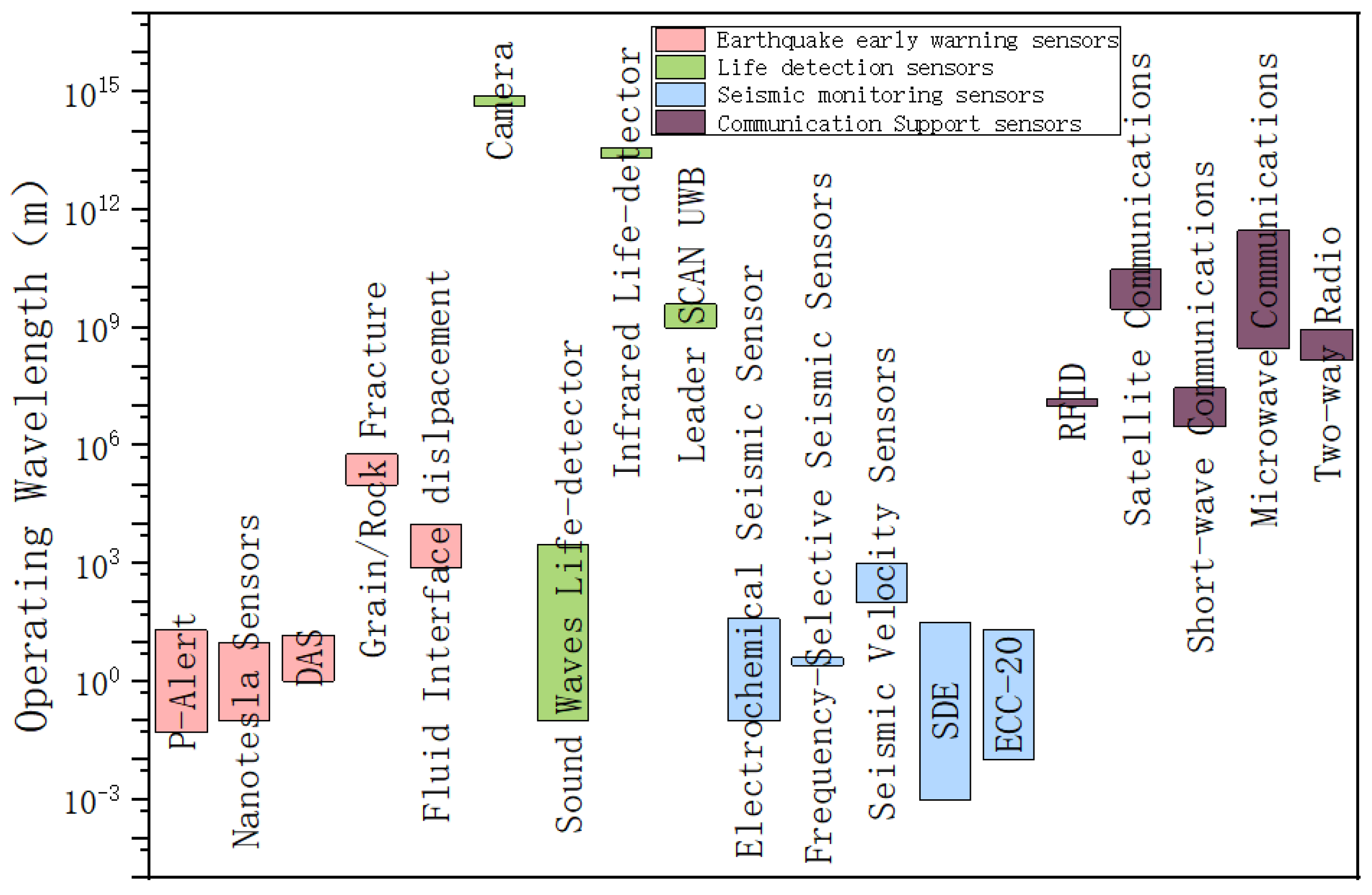
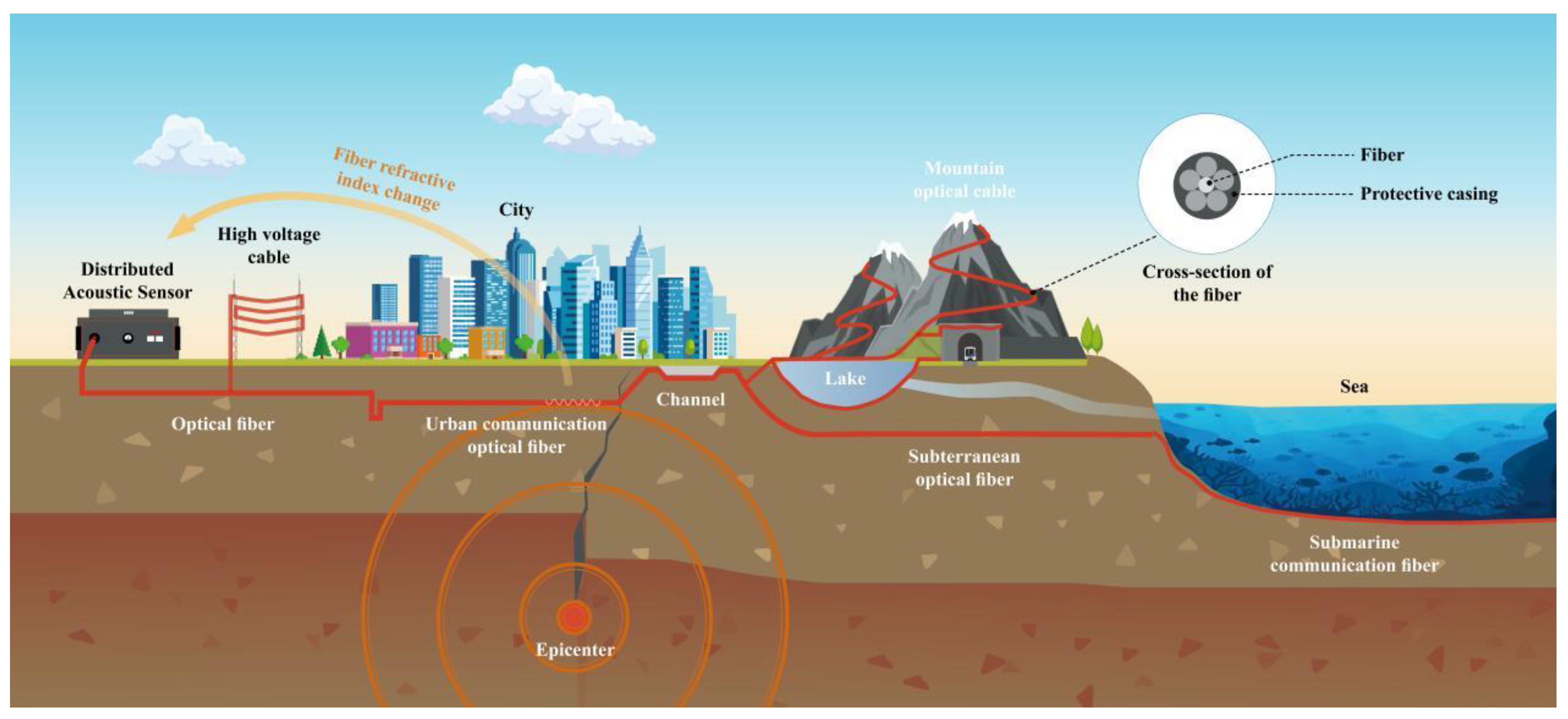
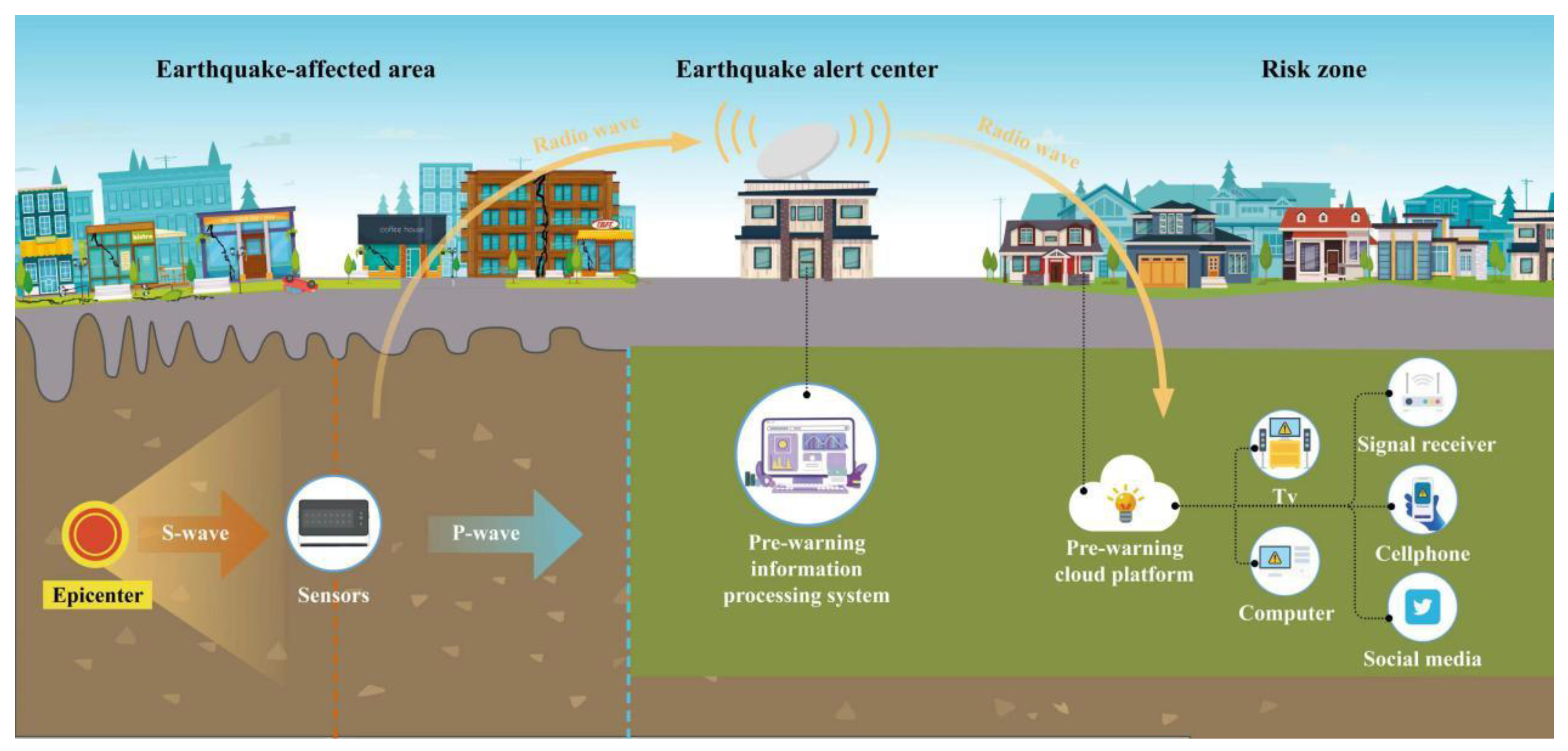
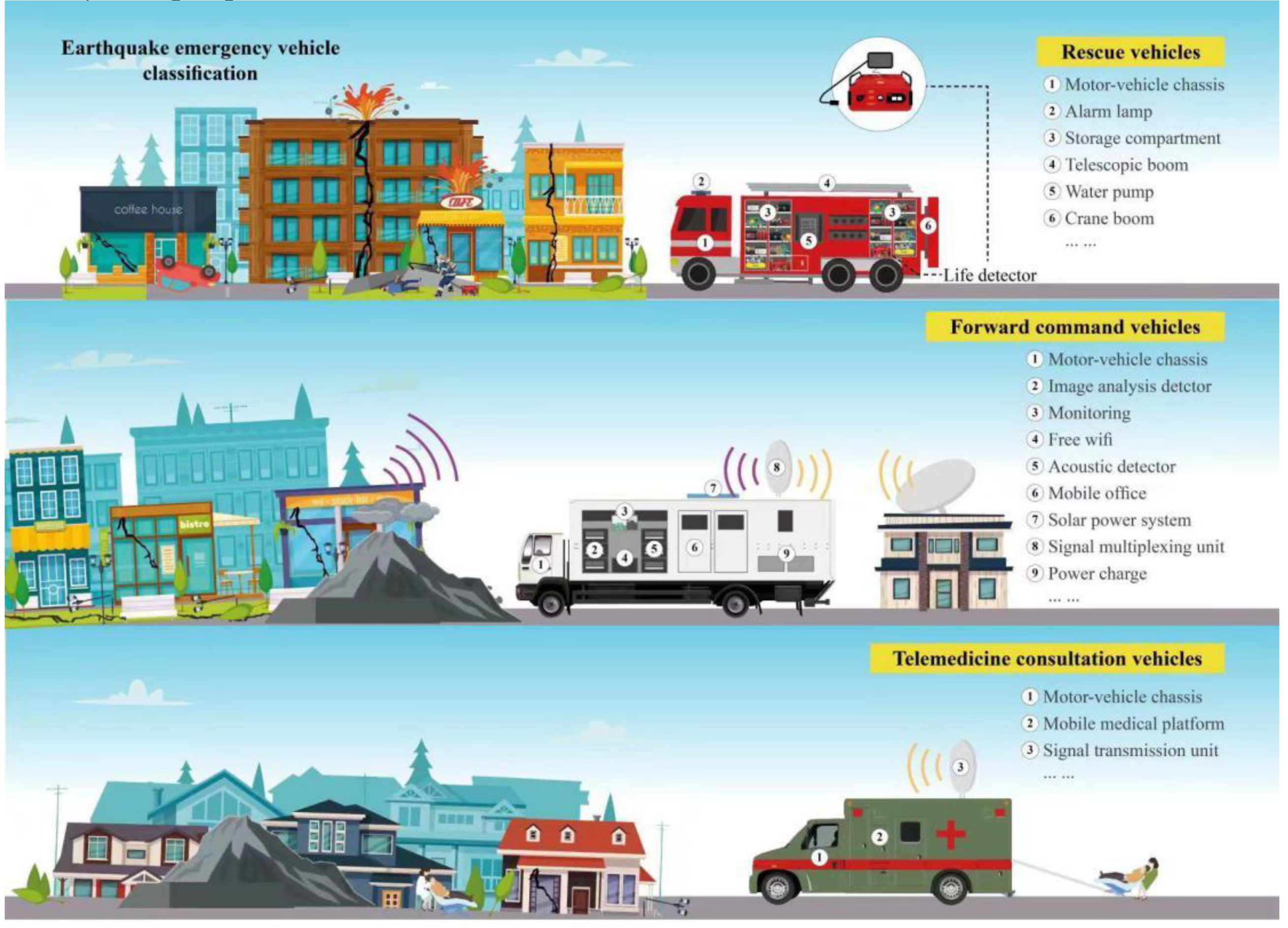
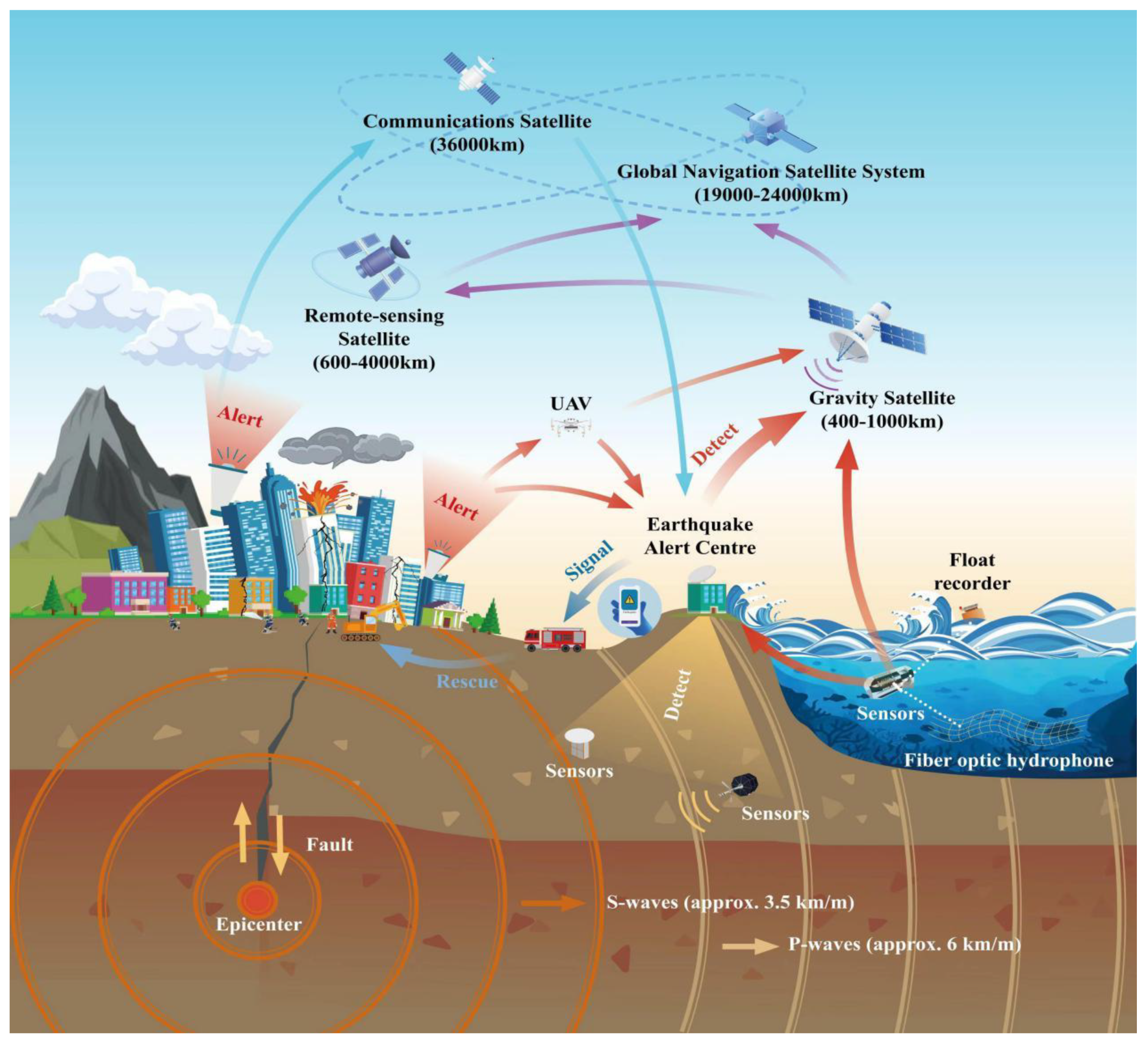
| Name | Type | Apply time | Theory | Height of application |
|---|---|---|---|---|
| Snake Eye Life detector | Life detector | 0-72hr | Intercom probe, video probe, infrared thermal imaging probe | ground |
| LEADER Hasty | Life detector | 0-72hr | It incorporates vibration signal listening, video search and calls to trapped people | ground |
| Airborne radar-photoelectric composite life detection system | Life detector | 0-72hr | Two-dimensional radar and visible/infrared cameras | low altitude |
| Native safety radar vibration compound life detector YSF40 | Life detector | 0-72hr | Intrinsically safe two-dimensional radar is combined with intrinsically safe wireless micro vibration sensor | ground |
| Prototype of portable locator employing chemical analysis | Life detector | 0-72hr | infrared (IR) camera and different gas sensors |
ground |
| DZQ 12-3A cascade engineering seismograph | Seismic prospecting | Long period | Using hammer strike, electric spark or explosion as the source, excite by observing and recording the travel time of seismic wave, detect the buried depth, shape and distribution law of different elastic stratum interface, so as to solve the problem of engineering and resource geophysical exploration, and explore the depth from several meters to hundreds of meters | Underground several meters to several kilometer |
| P-alert | Earthquake early warning | Long period | Earthquake P wave sensor, in addition to the traditional S wave detection function, but also embedded in the earthquake rapid report technology, can detect P wave and determine whether a catastrophic earthquake within 3 seconds. | Underground |
| Alpha GUARD | Earthquake early warning | Long period |
Seismic precursor analysis using atmospheric radon anomaly. |
ground |
| CG-5 Gravimeter | Seismic prospecting | Long period | Study the physical phenomena of gravity changes on the Earth’s surface and in the space around it. | ground |
| Distributed acoustic sensing, DAS | Earthquake early warning | Long period | The acoustic sensor detects the external signal in the optical fiber. By extracting and demodulation the interference signal of sound vibration at different time, the quantitative measurement of external physical quantity can be realized. | Underground |
| Radio-Frequency Identification (RFID) | Communication support | 0-72h for Life saving and after 72 h for other usage | RFID is a generic term for technologies that use radio waves to automatically identify people or objects | Ground |
| two-way radio system | Communication support | Provide the possibility of communication after the earthquake. |
A two-way radio is a radio that can both transmit and receive radio waves (a transceiver), unlike a broadcast receiver which only receives content. It is an audio (sound) transceiver, a transmitter and receiver in one unit, used for bidirectional person-to-person voice communication with other users with similar radios. | Above/below ground |
| Communications Satellite | Communication support | Long Period | Satellite communication is the communication between radio communication stations on Earth (including the ground and the lower atmosphere) using satellites as a medium. | upper air |
| UAV | Communication support | Provide communication after an earthquake | It is equipped with photoelectric detection pod, synthetic aperture radar, aerial CCD camera, emergency communication support pod, emergency delivery pod and other equipment to provide communication support and obtain front-line information | Up to 9000m |
Disclaimer/Publisher’s Note: The statements, opinions and data contained in all publications are solely those of the individual author(s) and contributor(s) and not of MDPI and/or the editor(s). MDPI and/or the editor(s) disclaim responsibility for any injury to people or property resulting from any ideas, methods, instructions or products referred to in the content. |
© 2023 by the authors. Licensee MDPI, Basel, Switzerland. This article is an open access article distributed under the terms and conditions of the Creative Commons Attribution (CC BY) license (http://creativecommons.org/licenses/by/4.0/).





